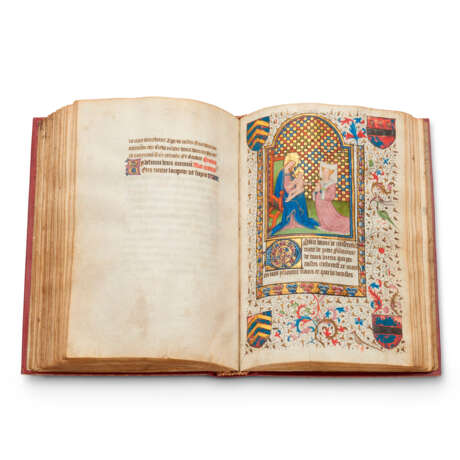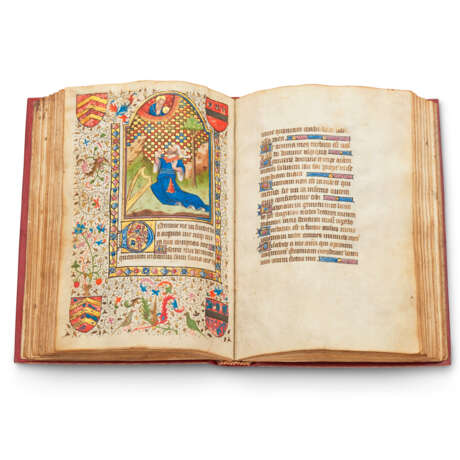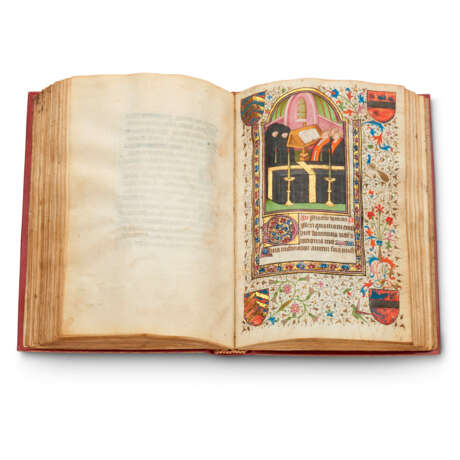ID 870895
Lot 39 | Master of Morgan MS. M.293
Valeur estimée
£ 30 000 – 50 000
Book of Hours, use of Paris, in Latin and French, illuminated manuscript on vellum [Besançon, c.1440]
A refined Book of Hours painted in Besançon for a female member of the Burgundian nobility, with intriguing records of family ownership in the Franche-Comté region for the following 200 years.
203 x 147mm. iii (ii-iii original vellum) + 103 + i, lacking one leaf, collation: 1-28, 34, 4-78, 87 (lacking i), 9-118, 126, 138, 146, 18 lines, ruled space: 105 x 77mm, written in two hands, rubrics in red, one-line initials in gold on blue and red grounds and similar two-line initials with gold ivy leaf extensions, 8 large four-line initials in red or blue on gold grounds in-filled with foliate branchwork decoration within full borders of ivy leaves on hairline stems, acorn leaves, fruit and flowers, containing grotesques and birds, surrounding three-quarter baguette frame, five large arch-topped miniatures with full borders and an armorial shield in each corner, rectos of the Calendar with three-quarter borders (lacking the first leaf of the Hours of the Cross, probably with a miniature of the Crucifixion, some of the armorial shields have been overpainted in blue and this has flaked; otherwise in excellent condition). Modern red morocco gilt over wooden boards. Box.
Provenance:
(1) Apparently made for the woman who appears kneeling before the Virgin and Child on f.78: her name may have been Catherine, as there is a long prayer to the saint on f.83, and her family came from the Franche-Comté region of Burgundy. The coats of arms in the borders of each miniature, presumably those of Catherine herself and perhaps a husband, have previously been identified as: [on the right-hand side of the page] Vellefaux (gules, a fesse argent three leopard faces in chief) and [on the left] the Fitigny family of Franche-Comté (gules, three chevrons or).
(2) The manuscript seems to have remained in the region for about 200 years. From 1541 to his death in 1562, it belonged to Etienne Cauquohin of Dijon, and after that to the Rougier family. On the two blank leaves at the beginning of the manuscript, throughout the Calendar and following eight leaves are recorded the births and deaths and events in the life of the Rougier family from 1566, physicians and medical practitioners in Dijon. Curiously, they also describe their own illnesses and ailments. In 1597, Rougier's daughter Anne married Jean Mailley and the book passed to their son Paul, ‘advocat au parlement de Dijon’. The last entry is in 1648, when his mother died aged 90. All the burials seem to have been at the church of St Jean in Dijon. The fly-leaves have small holes, suggesting that pilgrim badges were at one time sewn to them.
(3) Sotheby's, 6 July 1964, lot 244, sold as the property of Mrs Gaby Solomon of Buenos Aires.
(4) Christie’s, 29 November 1995, lot 9.
Contents:
Calendar ff.1-12; Gospel Sequences f.13-17; Obsecro te ff.17-20; Hours of the Virgin, use of Paris ff.21-50: matins f.21, lauds f.28, prime f.35, terce f.38, sext f.40v, none f.42v, vespers f.44v, compline f.48; Verses of St Bernard and other prayers f.51-52; Hours of the Cross (lacking opening leaf) ff.53-54; Hours of the Holy Spirit ff.54v-56; Penitential Psalms and Litany ff.56v-67v; Office of the Dead ff.68-77v; Fifteen Joys of the Virgin ff.78-81; Seven Requests of our Lord ff.81v-85; Suffrages and prayers ff.85v-95v, including a long suffrage to St Catherine; Salve virgo ff.92-95; Loueuse virge pucelle, added in a 16th-century hand ff.96-103.
Illumination:
The strong and simple forms of these miniatures, their ‘vibrant luminosity’, are typical of a miniaturist working in Besançon in about 1430. Plummer in The Last Flowering no 36 (New York, Morgan Library, MS. M.293) describes him as a follower of the Egerton Master, assuming that he had been trained in the Egerton Master's workshop in Paris. He lists 10 other manuscripts, including the present, made in Besançon and Dijon by the same artist. Avril and Reynaud describe an Hours for the use of Besançon of c. 1440 now at the Hague (Kgl. Bibliotheek ms 76), ascribing it to a follower of the illuminator of the present book who must also have practised in Besançon, based on the use of certain of his manuscripts (Les Manuscrits à peintures en France 1440-1520, 1993, no 109). They list related manuscripts in Vienna (ÖNB Cod.1881); Melbourne, State Library of Victoria (described in Manion & Vines, Medieval and Renaissance Illuminated Manuscripts in Australian Collections, pp. 182-3); Wellington, Alexander Turnbull Library (cf. Manion, Vines and de Hamel, Medieval & Renaissance Manuscripts in New Zealand Collections, pp. 119-120).
The subjects of the large miniatures are as follows: Annunciation f.21; Pentecost f.54v; David in Prayer f.57v; Funeral Mass f.69; Virgin and Child with a praying female patron f.78.
Special notice
No VAT on hammer price or buyer's premium.
| Lieu d'origine: | Europe de l'Ouest, France, Europe |
|---|---|
| Catégorie maison de vente aux enchères: | Manuscrits médiévaux et de la Renaissance |
| Lieu d'origine: | Europe de l'Ouest, France, Europe |
|---|---|
| Catégorie maison de vente aux enchères: | Manuscrits médiévaux et de la Renaissance |
| Adresse de l'enchère |
CHRISTIE'S 8 King Street, St. James's SW1Y 6QT London Royaume-Uni | |
|---|---|---|
| Aperçu |
| |
| Téléphone | +44 (0)20 7839 9060 | |
| Commission | see on Website | |
| Conditions d'utilisation | Conditions d'utilisation |







